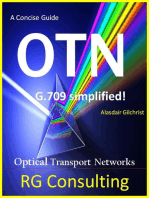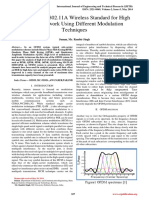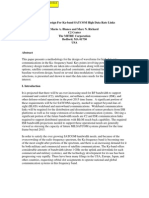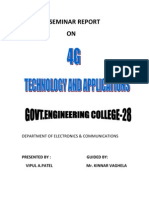Null Data Packet (NDP) Beamforming in 802.11ac: Channel Measurement (Sounding) Procedures
Uploaded by
sagarnitishpirtheeNull Data Packet (NDP) Beamforming in 802.11ac: Channel Measurement (Sounding) Procedures
Uploaded by
sagarnitishpirtheeNull Data Packet (NDP) Beamforming in 802.
11ac
One of the biggest changes between 802.11n and 802.11ac is that beamforming has been
dramatically simplified. Proprietary beamforming technologies had existed prior to
802.11n, but it was only in 802.11n that a standard for beamforming was introduced. In
the 802.11n specification, multiple beamforming methods were described. Before using
beamforming, both sides of the link had to agree on one method they shared, but due to
the complexity of implementing multiple methods, many product vendors chose not to
implement any. To avoid a repeat with 802.11ac, engineers writing the specification
settled on just one method of beamforming, called null data packet (NDP) sounding.
The second major change in beamforming with 802.11ac has not yet been realized, but it
has the potential to dramatically change how much data wireless networks can support.
802.11acs second wave of products will introduce multi-user MIMO, an application of
MIMO techniques that allows simultaneous transmission to multiple clients.
Channel measurement (sounding) procedures
Beamforming depends on channel calibration procedures, called channel sounding in
the 802.11ac standard, to determine how to radiate energy in a preferred direction.
Many factors may influence how to steer a beam in a particular direction. Within the
multi-carrier OFDM channel used by 802.11ac, there may be a strong frequencydependent response that requires limiting data rates over the channel. Alternatively,
between two 802.11ac devices, a particular frequency may respond much more strongly
to one path than another. Beamforming enables the endpoints at either side of a link to
get maximum performance by taking advantage of channels that have
strong performance while avoiding paths and carriers that have weak performance.
[36]
Mathematically, the ability to steer energy is represented by the steering matrix,
which is given the letter Q in 802.11ac. Matrices are used to represent steering
information because they are an excellent tool for representing the frequency response
from each transmission chain in the array over each transmission stream. Matrix
operations allow the spatial mapper to alter the signal to be transmitted for each OFDM
subcarrier over each path to the receiver in one operation. Naturally, after applying the
steering matrix to the data for transmission, it will leave the antenna array in a
decidedly non-omnidirectional pattern.
You might also like
- Lens Antenna Subarrays in Mmwave Hybrid MIMO SystemsNo ratings yetLens Antenna Subarrays in Mmwave Hybrid MIMO Systems11 pages
- Sensors: An Improved Channel Estimation Technique For IEEE 802.11p Standard in Vehicular CommunicationsNo ratings yetSensors: An Improved Channel Estimation Technique For IEEE 802.11p Standard in Vehicular Communications22 pages
- Connection Admission Grooming in PCE Based Architecture Incorporating Dynamic Fiber State Information With Combined RWANo ratings yetConnection Admission Grooming in PCE Based Architecture Incorporating Dynamic Fiber State Information With Combined RWA10 pages
- Wi-Fi Technology Note WF104: Migrating To 802.11n While Supporting Legacy 802.11b/g ApplicationsNo ratings yetWi-Fi Technology Note WF104: Migrating To 802.11n While Supporting Legacy 802.11b/g Applications6 pages
- Performance_Evaluation_of_IEEE_80211ac_and_80211n_No ratings yetPerformance_Evaluation_of_IEEE_80211ac_and_80211n_10 pages
- Addressing MAC Layer Inefficiency and Deafness of IEEE802.11ad Millimeter Wave Networks Using A Multi-Band ApproachNo ratings yetAddressing MAC Layer Inefficiency and Deafness of IEEE802.11ad Millimeter Wave Networks Using A Multi-Band Approach7 pages
- On The Performance of Ad Hoc Networks With Beamforming AntennasNo ratings yetOn The Performance of Ad Hoc Networks With Beamforming Antennas11 pages
- Improving Quality of Service Using Ofdm Technique For 4th Generation NetworkNo ratings yetImproving Quality of Service Using Ofdm Technique For 4th Generation Network6 pages
- Optical Networking and Dense Wavelength Division MultiplexingNo ratings yetOptical Networking and Dense Wavelength Division Multiplexing29 pages
- Migrating To 802.11n While Supporting Legacy 802.11b, G Applications (2006)No ratings yetMigrating To 802.11n While Supporting Legacy 802.11b, G Applications (2006)6 pages
- Backhaul Network Using Seamless Convergence of RoFNo ratings yetBackhaul Network Using Seamless Convergence of RoF10 pages
- S12 - Fiber Optics Communication - HeikkinenNo ratings yetS12 - Fiber Optics Communication - Heikkinen7 pages
- Reconfigurable Millimeter-Wave Components Based OnNo ratings yetReconfigurable Millimeter-Wave Components Based On39 pages
- Analog Beam Forming in MIMO Communications With Phase Shift Networks and OnlineNo ratings yetAnalog Beam Forming in MIMO Communications With Phase Shift Networks and Online13 pages
- Dmesh: Incorporating Practical Directional Antennas in Multichannel Wireless Mesh NetworksNo ratings yetDmesh: Incorporating Practical Directional Antennas in Multichannel Wireless Mesh Networks12 pages
- Optical Networking and Dense Wavelength Division Multiplexing (DWDM)No ratings yetOptical Networking and Dense Wavelength Division Multiplexing (DWDM)12 pages
- Channel EstimationEqualization With Adaptive Modulation and Coding Over Multipath Faded Channels For WiMAXNo ratings yetChannel EstimationEqualization With Adaptive Modulation and Coding Over Multipath Faded Channels For WiMAX8 pages
- 802.11n Demystified: Key Considerations For N-Abling The Wireless EnterpriseNo ratings yet802.11n Demystified: Key Considerations For N-Abling The Wireless Enterprise12 pages
- Using Switched Beam Smart Antennas in Wireless Ad Hoc Networks With Angular MAC ProtocolNo ratings yetUsing Switched Beam Smart Antennas in Wireless Ad Hoc Networks With Angular MAC Protocol11 pages
- Kocan2017 Article RangeExtensionInIEEE80211ahSysNo ratings yetKocan2017 Article RangeExtensionInIEEE80211ahSys22 pages
- Energies: Enhancing The Energy E MIMO by Modifying The RF Circuit ConfigurationNo ratings yetEnergies: Enhancing The Energy E MIMO by Modifying The RF Circuit Configuration23 pages
- Investigating 802.11A Wireless Standard For High Speed Network Using Different Modulation TechniquesNo ratings yetInvestigating 802.11A Wireless Standard For High Speed Network Using Different Modulation Techniques5 pages
- Analysis of Research Articles: BouchouchayosraNo ratings yetAnalysis of Research Articles: Bouchouchayosra42 pages
- Angle of arrival estimation in a multi-antenna software defined radioNo ratings yetAngle of arrival estimation in a multi-antenna software defined radio12 pages
- Improving The System Spectral EfficiencyNo ratings yetImproving The System Spectral Efficiency5 pages
- Many-to-Many Beam Alignment in Millimeter Wave NetworksNo ratings yetMany-to-Many Beam Alignment in Millimeter Wave Networks18 pages
- IJNAA Volume 13 Issue 2 Pages 1053-1067No ratings yetIJNAA Volume 13 Issue 2 Pages 1053-106715 pages
- Efficient Network Level Beamforming Training For Ieee 802.11ad WlansNo ratings yetEfficient Network Level Beamforming Training For Ieee 802.11ad Wlans6 pages
- The Challenges of Testing MIMO: Next-Generation WirelessNo ratings yetThe Challenges of Testing MIMO: Next-Generation Wireless5 pages
- A Seminar Report: Department of Electronics & CommunicationsNo ratings yetA Seminar Report: Department of Electronics & Communications7 pages
- Optical Code-Division Multiple Access Using Broad-Band Parametrically Generated LightNo ratings yetOptical Code-Division Multiple Access Using Broad-Band Parametrically Generated Light9 pages
- Antenna Array Design For Multi-Gbps Mmwave Mobile Broadband CommunicationNo ratings yetAntenna Array Design For Multi-Gbps Mmwave Mobile Broadband Communication6 pages
- S A T T A W A H N: Mart Ntenna Echniques and Heir Pplication To Ireless D OC EtworksNo ratings yetS A T T A W A H N: Mart Ntenna Echniques and Heir Pplication To Ireless D OC Etworks7 pages
- Directional Random Access Scheme For Mobile Ad Hoc Networking Using Beamforming AntennasNo ratings yetDirectional Random Access Scheme For Mobile Ad Hoc Networking Using Beamforming Antennas27 pages
- Overhead Estimation Over Capacity of Mobile WiMAXNo ratings yetOverhead Estimation Over Capacity of Mobile WiMAX6 pages
- Radio Propagation and Adaptive Antennas for Wireless Communication Networks: Terrestrial, Atmospheric, and IonosphericFrom EverandRadio Propagation and Adaptive Antennas for Wireless Communication Networks: Terrestrial, Atmospheric, and IonosphericNo ratings yet
- Recommendation Government Agency Status Time FrameNo ratings yetRecommendation Government Agency Status Time Frame5 pages
- Archive Plotter User Guide: BTD-300 Thunderstorm DetectorNo ratings yetArchive Plotter User Guide: BTD-300 Thunderstorm Detector6 pages
- Cambridge International Examinations Cambridge International Advanced Subsidiary and Advanced LevelNo ratings yetCambridge International Examinations Cambridge International Advanced Subsidiary and Advanced Level18 pages
- Cambridge International Examinations Cambridge International Advanced Subsidiary and Advanced LevelNo ratings yetCambridge International Examinations Cambridge International Advanced Subsidiary and Advanced Level10 pages
- Hinduism Questions Unit 3: Unit 3 4 Mark Do You Think That Making Offerings To Gods Is A Waste of Good Food?No ratings yetHinduism Questions Unit 3: Unit 3 4 Mark Do You Think That Making Offerings To Gods Is A Waste of Good Food?8 pages
- Sir Leckraz Teelock State Secondary School - C/Flacq 3 Term Final Exams - October 2001 Form I - Integrated Science (Time: 1 Hours)No ratings yetSir Leckraz Teelock State Secondary School - C/Flacq 3 Term Final Exams - October 2001 Form I - Integrated Science (Time: 1 Hours)9 pages











































































